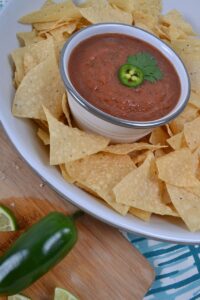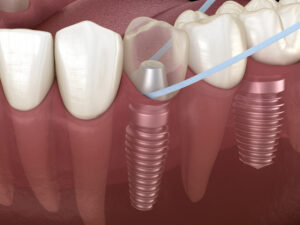Are There Food Restrictions with Dental Implants?
 Dental implants are rapidly becoming the standard in missing tooth replacement. They are versatile in that we can use them in many different ways. Some people have a single missing tooth that requires a single dental implant with a standalone crown. Others are missing all of their teeth, and we use multiple implants to fasten to a complex dental prosthesis. The possibilities are almost endless!
Dental implants are rapidly becoming the standard in missing tooth replacement. They are versatile in that we can use them in many different ways. Some people have a single missing tooth that requires a single dental implant with a standalone crown. Others are missing all of their teeth, and we use multiple implants to fasten to a complex dental prosthesis. The possibilities are almost endless!
One of the greatest advantages of dental implants over other tooth replacement options is that they provide the best and most natural chewing ability. This means that there are far fewer food restrictions with dental implants than with other tooth replacements. Implants provide a high level of stability, and there are only a few precautions you should follow.
Precautions Immediately Following Implant Surgery
The dental implant process begins with the surgical phase. This is the appointment during which your dentist places the implant into the jawbone to replace the missing tooth’s root. Immediately following the implant placement surgery, there is a very important healing phase that must take place. During this healing period, a process called osseointegration occurs between the dental implant root form and the surrounding jawbone. Osseointegration creates a solid attachment between the implant and the bone, and this attachment is the source of all stability and chewing force the implant can withstand in the future.
In order for osseointegration to successfully occur, you must place zero pressure or force on the implant. This is relatively easy because the implant is below the gums. However, sometimes it is possible for pressure from chewing to reach this area. For this reason, your eating restrictions will involve chewing only on the opposite side from your implant surgery.
Do not chew on the newly placed dental implant site!
Precautions after Implant Healing
 After the implant has obtained osseointegration, there may be a waiting period before you receive your dental crown or other prosthesis. This waiting period may be due to manufacturing time in the dental lab or your own desire to delay treatment. During this time, the implant maintains its solid attachment to the jawbone and is protected underneath the gum tissue.
After the implant has obtained osseointegration, there may be a waiting period before you receive your dental crown or other prosthesis. This waiting period may be due to manufacturing time in the dental lab or your own desire to delay treatment. During this time, the implant maintains its solid attachment to the jawbone and is protected underneath the gum tissue.
The only restriction necessary during this phase is to avoid sharp edges that could cut or damage the gums over the implant. Without the tooth or crown in place, that area is vulnerable to stabbing with tortilla chips or hard crackers.
Precautions after Implant Crown is Placed

When your dentist places your implant crown, it restores your chewing ability to full force! You can being “using” the new crown immediately, and you will be surprised by how much improved your chewing ability becomes. Most dental implant crowns adhere to the underlying implant through the use of a dental cement.
Dental cements require a short time to fully set or harden. For this reason, we typically advise our patients to avoid chewing gum, sticky candy or any other food that could dislodge the new crown for the first one to two days.
Long-Term Precautions
 Patients with dental implants may notice some food impaction “under” the implant crown. This is because implants are typically smaller in diameter than a natural tooth’s root trunk is. So while the biting portion of the dental crown is the same size as a natural tooth, it must narrow down to a smaller diameter where it meets the gums and the underlying implant. This may lead to gaps between the crown and the gums that are perfect hiding spots for food and dental plaque.
Patients with dental implants may notice some food impaction “under” the implant crown. This is because implants are typically smaller in diameter than a natural tooth’s root trunk is. So while the biting portion of the dental crown is the same size as a natural tooth, it must narrow down to a smaller diameter where it meets the gums and the underlying implant. This may lead to gaps between the crown and the gums that are perfect hiding spots for food and dental plaque.
The great news is that this food impaction cannot cause a cavity on your dental implant. Titanium is impervious to the bacteria that break through enamel. Food buildup can, however, cause gum disease, so you must commit to cleaning the area around your dental implant diligently and consistently.
When you see Phyllis or Nancy for your professional teeth cleaning, they may recommend specific tools to add to your oral hygiene routine to remove plaque or food from these areas. We particularly like GUM’s SoftPicks, which will clean the open spaces without damaging your gums.
As you chew with your implant crown over time, you may begin to notice that a particular food is more likely to stick between the implant and the neighboring tooth. For some, it is barbecue chicken or other stringy meats. Others notice that the space under the crown is just the right size for a grain of rice. Regardless of what food causes the impaction, it is your responsibility to be aware of it and either avoid that food or take steps to quickly clean your implant after eating it.
More Questions about Eating with Dental Implants?
Call Designer Smiles today to schedule a consultation with Dr. Ann. She is a dental implant expert and can assess your unique situation to make customized recommendations for you. We love restoring our patients’ ability to chew the foods they enjoy with dental implants.
